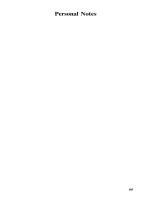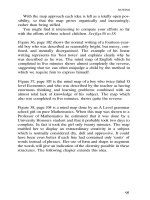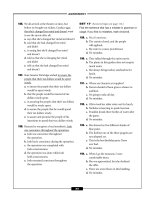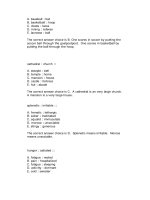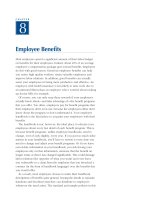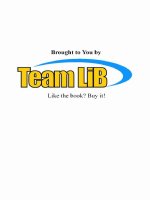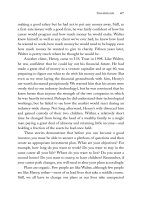101 activities foteaching creativity and problem solving phần 4 ppt
Bạn đang xem bản rút gọn của tài liệu. Xem và tải ngay bản đầy đủ của tài liệu tại đây (367.22 KB, 41 trang )
111
Ticklers: Related and Unrelated Stimuli
101 Activities for Teaching Creativity and Problem Solving. Copyright © 2005 by John Wiley &
Sons, Inc. Reproduced by permission of Pfeiffer, an Imprint of Wiley. www.pfeiffer.com
20
TEXT TICKLER
Background
Many people like to read for entertainment or to learn something new. For some people,
there’s nothing like curling up with a good novel. Reading helps tickle our gray matter,
whether the material is Shakespeare or a clothing catalog. The more we read, the more
stimulation we receive.
Sometimes, when we least expect it, a potential solution will pop out as we read. This
may happen through some subconscious association or because we occasionally ponder a
current problem while reading and something we read sparks an idea. Although such
ideas may frequently occur by chance, we can make idea generation more predictable.
That’s where the Text Tickler exercise can help.
Text Tickler involves randomly selecting words from different sources and then using
them to prompt ideas. It doesn’t matter where you get the words, as long as you have a
varied pool from which to choose.
Objectives
• To help participants generate as many creative ideas as possible
• To help participants learn how to use the activities to generate ideas
Participants
Small groups of four to seven people each
Materials, Supplies, and Equipment
• For each group: markers, two flip charts, and masking tape for posting flip-chart
sheets
• For each participant: one sheet each of three different colors of sticking dots
(
1
⁄2” diameter) and one pad of 4 x 6 Post-it
®
Notes.
Handout
• Text Tickler Handout
05 VG 77-118b 10/5/04 5:05 PM Page 111
TLFeBOOK
112
101 Activities for Teaching Creativity and Problem Solving
101 Activities for Teaching Creativity and Problem Solving. Copyright © 2005 by John Wiley &
Sons, Inc. Reproduced by permission of Pfeiffer, an Imprint of Wiley. www.pfeiffer.com
Time
30 minutes
Related Activities
• A Likely Story [15]
• PICLed Brains [16]
• Say What? [19]
Procedure
1. Prior to the session, gather an assortment of old books, catalogs, magazines, news-
papers, or any source of words, including dictionaries, to distribute during the
session.
2. Distribute the Text Tickler Handout and discuss it with the participants, answer-
ing questions they might have.
3. At the start of the session, distribute at least one source of stimuli (a magazine or
catalog) to each group member.
4. Instruct each participant to select a word or phrase from his or her word source.
5. Tell them to examine the word or phrase and use it to trigger at least one idea and
write it on a Post-it
®
Note.
6. Have the group members pass their Post-it
®
Notes to the person on their right and
tell them to write down any new ideas stimulated.
7. Tell the groups to repeat Steps 3 through 5 and conclude once all group members
have selected and reported on a random word and generated an idea or when
time is no longer available.
8. Have them place the notes on flip charts for evaluation.
Debrief/Discussion
This technique should appeal especially well to people who are good at creating visual
images from reading different words. It also helps people who can free-associate easily so
that one word leads to another, thus creating different perspectives.
To facilitate a discussion, try the following types of questions:
• Did some words lead to more ideas than others? If so, what were they and why?
• What types of problems might this activity work best with and why?
• Why is it important that the stimulus words be different from the problem challenge?
Also, consider having participants debrief using the following questions:
• What was most helpful about this exercise?
• What was most challenging?
05 VG 77-118b 10/5/04 5:05 PM Page 112
TLFeBOOK
113
Ticklers: Related and Unrelated Stimuli
• What can we apply?
• How would you rate the value of this exercise to helping us with this issue?
• Will this exercise be helpful in the future for other sessions?
• What did you learn?
• What will we be able to use from this exercise?
• What ideas were generated, and which ones were most interesting?
05 VG 77-118b 10/5/04 5:05 PM Page 113
TLFeBOOK
114
101 Activities for Teaching Creativity and Problem Solving
101 Activities for Teaching Creativity and Problem Solving. Copyright © 2005 by John Wiley &
Sons, Inc. Reproduced by permission of Pfeiffer, an Imprint of Wiley. www.pfeiffer.com
Text Tickler Handout
Assume you own a hotel chain and want to attract more customers. First, you need to
select some random stimulus words. You are reading a newspaper while flying with sev-
eral of your staff members to visit one of your hotels.
While reading movie reviews, you see the word “grumpy.” This word sparks the idea
of offering “Grumpy Room Service.” All food orders are delivered by a grumpy delivery
person as a novelty service. Or in another variation of Grumpy Room Service, give guests
a free meal if any staff member treats them grumpily. Then look for another word and
choose “research.” This word might trigger the idea of in-room computers with easy-to-
access business databases for the business traveler. Finally, you see the word “film” and
think of installing picture phones in all the rooms.
05 VG 77-118b 10/5/04 5:05 PM Page 114
TLFeBOOK
115
Ticklers: Related and Unrelated Stimuli
101 Activities for Teaching Creativity and Problem Solving. Copyright © 2005 by John Wiley &
Sons, Inc. Reproduced by permission of Pfeiffer, an Imprint of Wiley. www.pfeiffer.com
21
TICKLER THINGS
Background
Everybody has things. They’re all around us. Life would be boring without things. They
make our world more interesting by providing us with varied stimuli.
We can see, touch, hear, taste, and smell things. Although specific things may give us
pleasure or pain, all things stimulate us. They provide something to which we can react in
a number of ways, depending on our personalities and previous experiences. The new
perspectives things can give us are the basis for this technique, a cousin of PICLed Brains
[16], Picture Tickler [17], and Text Tickler [20].
Objectives
• To help participants generate as many creative ideas as possible
• To help participants learn how to use the activities to generate ideas
Participants
Small groups of four to seven people each
Materials, Supplies, and Equipment
• For each group: markers, two flip charts, and masking tape for posting flip-chart
sheets
• For each participant: one sheet each of three different colors of sticking dots
(
1
⁄2” diameter) and one pad of 4 x 6 Post-it
®
Notes
Handout
• Tickler Things Handout
Time
30 minutes
05 VG 77-118b 10/5/04 5:05 PM Page 115
TLFeBOOK
116
101 Activities for Teaching Creativity and Problem Solving
Related Activities
• Idea Shopping [14]
• Grab Bag Forced Association [75]
Procedure
1. Distribute the Tickler Things Handout and discuss it with the participants,
answering questions they might have.
2. Gather an assortment of objects representing varied types of things. Examples
include pipe cleaners, clay, toy balls, plastic animals, light bulbs, books, radios,
candles, watches, telephones, bottles, cans, et cetera. All objects should be unrelat-
ed to the problem.
3. Place at least six different objects on each table with small groups of participants.
4. Distribute the handouts to each participant and review the example.
5. Instruct each group to select an object unrelated to the problem, and ask if there
are any questions.
6. Have them describe the object in some detail. Encourage them to include physical
characteristics as well as how people react to the object and use it. Remind them
that action descriptions are important, so they shouldn’t limit themselves to sin-
gle-word nouns.
7. Tell them to use their descriptions to stimulate ideas and assign someone to write
down each idea on a Post-it
®
Note and place it on a flip chart.
8. Instruct them to repeat Steps 5 through 7 until they have generated at least twenty
ideas or run out of time.
Debrief/Discussion
One positive feature of this exercise is its use of tangible objects. Thus, it is well suited for
those with less ability to visualize and free-associate. The use of an actual object that can
be seen and touched makes it easier for some to relate to and play off of for stimulation. If
you want to lead a discussion, you could ask the groups to compare differences in using
unrelated words, pictures, or objects as idea triggers.
Also consider having participants debrief using the following questions:
• What was most helpful about this exercise?
• What was most challenging?
• What can we apply?
• How would you rate the value of this exercise to helping us with this issue?
• Will this exercise be helpful in the future for other sessions?
• What did you learn?
• What will we be able to use from this exercise?
• What ideas were generated, and which ones were most interesting?
05 VG 77-118b 10/5/04 5:05 PM Page 116
TLFeBOOK
117
Ticklers: Related and Unrelated Stimuli
101 Activities for Teaching Creativity and Problem Solving. Copyright © 2005 by John Wiley &
Sons, Inc. Reproduced by permission of Pfeiffer, an Imprint of Wiley. www.pfeiffer.com
Tickler Things Handout
Assume you are an executive flying to a hotel site with several staff members. You want
more ideas for attracting customers. One of your managers suggests using an airplane
seat as the stimulus object. Right away, Nan (Ms. Creativity) Smith suggests recliner
chairs in hotel rooms. Other staff members chime in with such ideas as stereo headsets in
rooms and special beds with mattresses that can be raised and lowered.
You next challenge your staff members to use an airplane as a stimulus. Nan immedi-
ately suggests theme hotel rooms such as aeronautical or outer space rooms. Even Robert
(Mr. Analytical) Jones has an idea: join with an airline to offer special discounts for people
who fly the airline and stay at your hotel.
05 VG 77-118b 10/5/04 5:05 PM Page 117
TLFeBOOK
05 VG 77-118b 10/5/04 5:05 PM Page 118
TLFeBOOK


